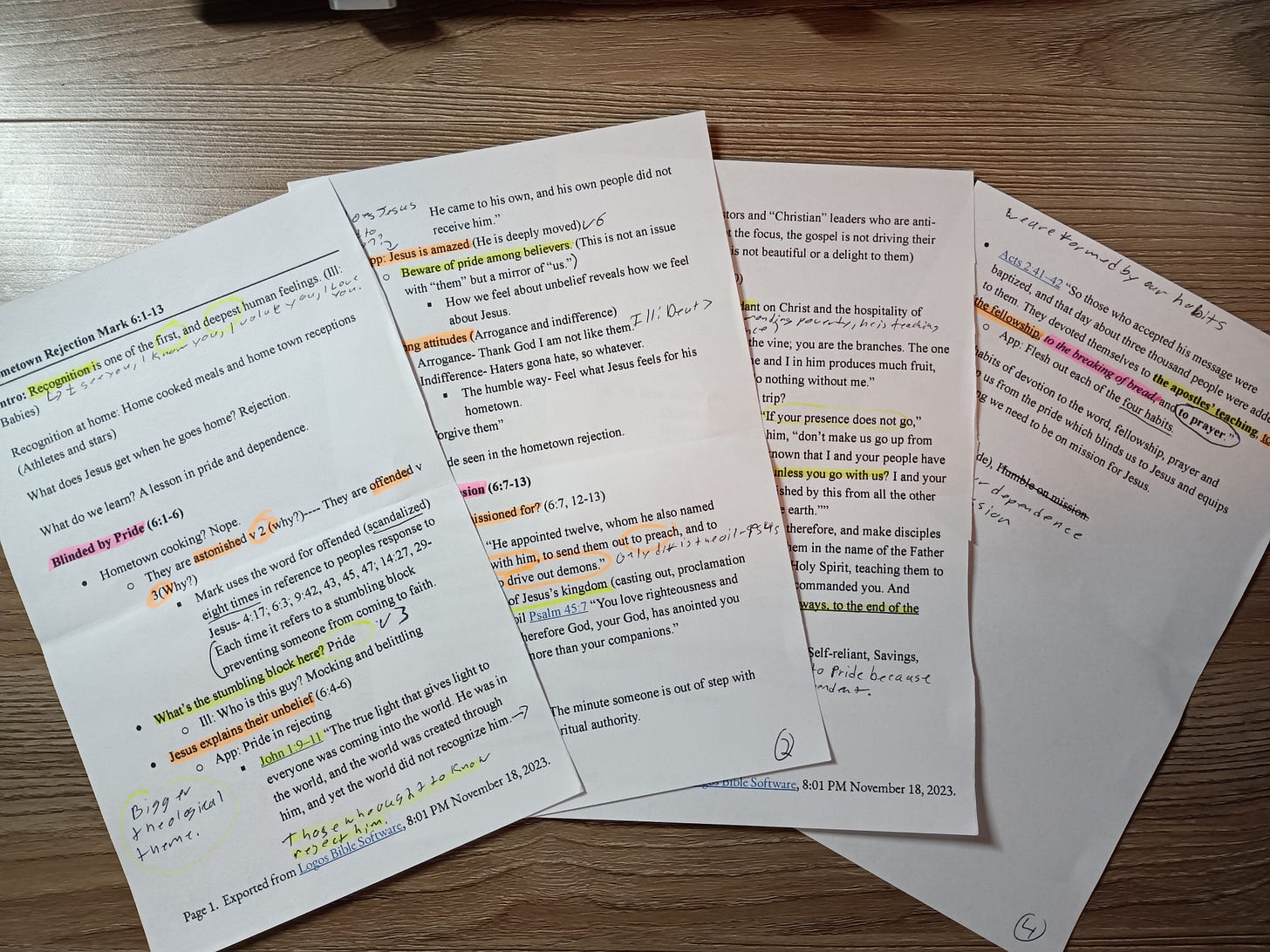I wasn’t sure what to write about this week so I thought it’d be fun to share my process for preparing sermons. If you’ve ever wondered how your pastor gets ready for Sunday morning, maybe a window into my process can help.
My preparation pathway has four stages: In the Text, In Conversation, On the Street, and Heading to the Pulpit.
One note, I don’t mention prayer in these stages because prayer is essential in the entire process. The ministry of the word is always soaked in prayer (Acts 6:4). Prayer comes before, continues through and follows after every step of sermon preparation.
In the Text
My normal practice is to preach through books of the Bible. I’m currently preaching through Mark. The first step is to sit down, open my Bible and read. I’m not reading for inspiration but studying until I have a strong sense of the passage's big idea.
I have four habits for this part of the process:
Read, reread and reread the text.
Map the structure: How is the passage arranged? What does the arrangement emphasize?
Think through the context: Why does the author put this passage in this place? How does the context inform the passage?
State the author's aim: What is the argument of the text? What is the author aiming to persuade the readers of? (I will try to do this in one short sentence).
In this step, I use multiple Bibles: different translations (primarily CSB, ESV and NIV), a Scripture notebook, a Reader’s Bible and an audio Bible. I want to immerse myself in the text as much as possible so that I can reflect on it throughout the week. Besides the audio Bible, I won’t use any digital tools at this point. I’ve found using paper and pen for this stage is better for my soul and my prep.
In Conversation
Once I have an idea about the point of the passage, I will begin using other resources. I call this step “In Conversation” because the point is dialogue. Pastors do a disservice to themselves and their congregation by regurgitating a commentary or a ChatGPT sermon on Sunday morning. They lose the benefits of learning how others have read the text, thinking through their convictions and sharpening their faith through dialogue. So this step is not “copy the experts” but test your understanding through conversation. Conversations with people and conversations with commentaries.
Conversations with church members, other Christians, my wife and even my kids have been crucial in my sermon prep. Preaching connects God’s word to people’s lives. Therefore conversation with “not Bible scholars” is very helpful for sermon prep.
When it comes to commentaries, I try to use a variety: study bibles, technical, devotional, or expositional. I use mostly digital commentaries. Years ago I bought Logos Bible Software and have greatly benefited from it. Using Logos Bible software gives me access to more and better resources and helps me better record and use what I’ve learned.
My goal at this stage is to read the text in conversation with others, testing and sharpening the big idea from step 1.
On the Street
When I’ve studied the passage and read it in conversation with others, I want to lean into application. Every passage of scripture applies a certain pressure and good preaching applies the pressure of the text to the life of the church. It can correct, comfort or instruct. In this stage, I try to imagine different people in my church asking me 2 questions: So What? Why does this matter?
Application may be the hardest part of preaching. A good sermon will be practical but how can it be practical for someone living in a nursing home and the university student barely getting through exams and the couple who just had a miscarriage and the family with six kids and many others in the congregation week after week? Application to such a wide range of people is challenging but a good pastor will do his best to connect the point of the passage to their lives in real and faithful ways.
In each sermon, I try to have one primary application and multiple secondary applications. For example, when I preached on Mark 1:16-45 the primary application was: Discipleship is a call to follow Jesus. In the sermon, I made other applications around this core idea.
We follow Jesus by:
Obeying him without hesitation (Mark 1:16-20)
Learning from him as our teacher (Mark 1:21-38)
Trusting him to make us whole (Mark 1:39-45)
Good applications are tied to the main point of the text and tangible in the lives of the listeners.
Heading to the Pulpit
At this stage, I build my sermon document. I used to write a full manuscript and then trim it into an outline but I don’t anymore. I take extensive notes in the other steps of my preparation which helps me get clear about the sermon. I’ll take those notes and use them to build a sermon outline.
My goal is to bring as little as possible into the pulpit on Sunday morning. This tends to be 3-4 half pages. The outline has my main points, key quotes, references and talking points. Sometimes I will write out a point in full, other times I will use trigger words. The outline always gets covered in highlighters. Each colour may have a reference, or they may just be visual cues showing me where I am and where I’m going.
My sermon notes from Nov 19.
Eye contact is key for good preaching. Building my outline this way keeps my head out of my notes so that my eyes can connect with my church family.
Finally, I review my outline three times. Saturday morning when I send notes to our tech team, Saturday night, and Sunday morning before the service.
And that’s how I prepare to preach. The process isn’t mechanical and it rarely happens in this neat order. But this pathway is how I ensure I study the Word in-depth and do my best to be faithful to the Lord and helpful to the church when I preach.
Every pastor who takes God’s word and his responsibility as a shepherd seriously will work hard in preparing to preach. Pray for your pastor. Encourage them in their preaching. And feast on the word of God as you sit under godly, biblical preaching.



